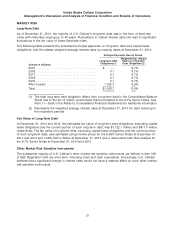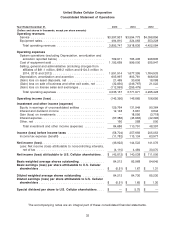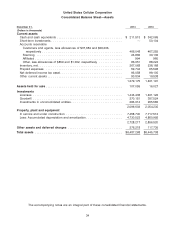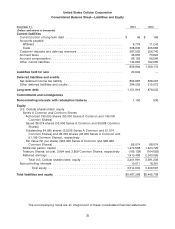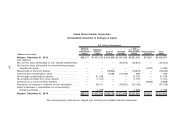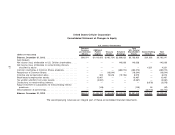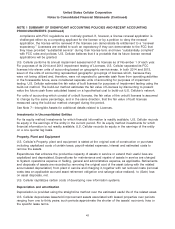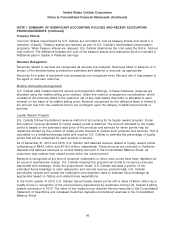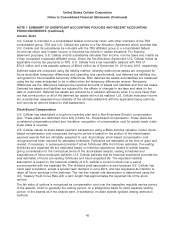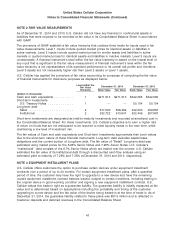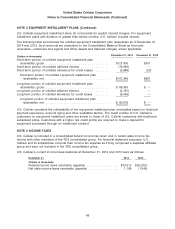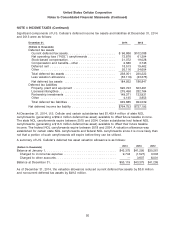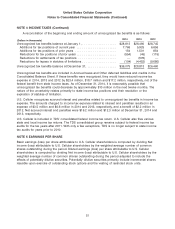US Cellular 2014 Annual Report Download - page 49
Download and view the complete annual report
Please find page 49 of the 2014 US Cellular annual report below. You can navigate through the pages in the report by either clicking on the pages listed below, or by using the keyword search tool below to find specific information within the annual report.United States Cellular Corporation
Notes to Consolidated Financial Statements (Continued)
NOTE 1 SUMMARY OF SIGNIFICANT ACCOUNTING POLICIES AND RECENT ACCOUNTING
PRONOUNCEMENTS (Continued)
compliance with FCC regulations are routinely granted. If, however, a license renewal application is
challenged either by a competing applicant for the license or by a petition to deny the renewal
application, the license will be renewed if the licensee can demonstrate its entitlement to a ‘‘renewal
expectancy.’’ Licensees are entitled to such an expectancy if they can demonstrate to the FCC that
they have provided ‘‘substantial service’’ during their license term and have ‘‘substantially complied’’
with FCC rules and policies. U.S. Cellular believes that it is probable that its future license renewal
applications will be granted.
U.S. Cellular performs its annual impairment assessment of its licenses as of November 1 of each year.
For purposes of its 2014 and 2013 impairment testing of Licenses, U.S. Cellular separated its FCC
licenses into eleven units of accounting based on geographic service areas. In both 2014 and 2013,
seven of the units of accounting represented geographic groupings of licenses which, because they
were not being utilized and, therefore, were not expected to generate cash flows from operating activities
in the foreseeable future, were considered separate units of accounting for purposes of impairment
testing. U.S. Cellular estimates the fair value of built licenses for purposes of impairment testing using the
build-out method. The build-out method estimates the fair value of Licenses by discounting to present
value the future cash flows calculated based on a hypothetical cost to build-out U.S. Cellular’s network.
For units of accounting which consist of unbuilt licenses, the fair value of the unbuilt licenses is assumed
to change by the same percentage, and in the same direction, that the fair value of built licenses
measured using the build-out method changed during the period.
See Note 7—Intangible Assets for additional details related to Licenses.
Investments in Unconsolidated Entities
For its equity method investments for which financial information is readily available, U.S. Cellular records
its equity in the earnings of the entity in the current period. For its equity method investments for which
financial information is not readily available, U.S. Cellular records its equity in the earnings of the entity
on a one quarter lag basis.
Property, Plant and Equipment
U.S. Cellular’s Property, plant and equipment is stated at the original cost of construction or purchase
including capitalized costs of certain taxes, payroll-related expenses, interest and estimated costs to
remove the assets.
Expenditures that enhance the productive capacity of assets in service or extend their useful lives are
capitalized and depreciated. Expenditures for maintenance and repairs of assets in service are charged
to System operations expense or Selling, general and administrative expense, as applicable. Retirements
and disposals of assets are recorded by removing the original cost of the asset (along with the related
accumulated depreciation) from plant in service and charging it, together with net removal costs (removal
costs less an applicable accrued asset retirement obligation and salvage value realized), to (Gain) loss
on asset disposals, net.
U.S. Cellular capitalizes certain costs of developing new information systems.
Depreciation and amortization
Depreciation is provided using the straight-line method over the estimated useful life of the related asset.
U.S. Cellular depreciates leasehold improvement assets associated with leased properties over periods
ranging from one to thirty years; such periods approximate the shorter of the assets’ economic lives or
the specific lease terms.
41


